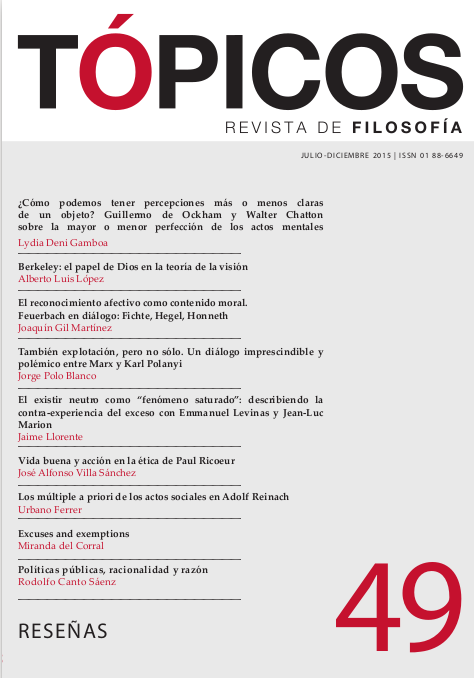El existir neutro como “fenómeno saturado”: describiendo la contra-experiencia del exceso con Emmanuel Levinas y Jean-Luc Marion
Publicado 2015-07-31
Palabras clave
- Levinas,
- Marion,
- fenómeno saturado,
- “hay”,
- exceso
- neutralidad ...Más
Cómo citar
Resumen
El propósito del presente estudio es mostrar que el il y a o existir neutro que constituye uno de los temas recurrentes abordados por Levinas en sus primeras obras de finales de los años cuarenta (De l´evasion, De ´existence à l´existant y Le temps et l´autre), pertenece plenamente a la categoría descrita por la fenomenología del don de Jean-Luc Marion bajo la denominación de “fenómeno saturado” o “paradoja”. En orden a poner de relieve tal pertenencia, se examinan las cuatro figuras o atributos que definen el exceso de donación intuitiva propio de todo fenómeno saturado atendiendo a su grado de coincidencia con el modo en el que Levinas describe la singular experiencia de exposición a la neutralidad del existir sin existentes. Esta postulada identificación entre ambos elementos supone una ampliación del horizonte fenomenológico potencialmente fructífera desde el punto de vista de la posible superación de la metafísica tradicional.
Referencias
- Blanchot, M. (1994). El paso [no] más allá. J. M. Ripalda (Trad.) Barcelona: Paidós.
- Chalier, C. (2004). La huella del infinito. Emmanuel Levinas y la fuente hebrea. Barcelona: Herder.
- ____ (2006). Figures du fémenin. Lecture d´Emmanuel Levinas. Paris: Des femmes-Antoinette Fouque.
- Critchley, S. (2007). Muy poco...casi nada. E. Julibert y R. Vilá (Trad.) Barcelona: Marbot.
- Domínguez Rey, A. (1997). La llamada exótica. El pensamiento de Emmanuel Levinas. Madrid: Trotta.
- Gschwandtner, C. M. (2007). Reading Jean-Luc Marion. Exceeding Metaphysics. Bloomington: Indiana University Press.
- Hegel, G.W.F. (1969). Wissenschaft der Logik. Frankfurt: Suhrkamp.
- Heidegger, M. (1976a). Wegmarken, Frankfurt am Main: Vittorio Klostermann, 1976.
- ____ (1976b). Zur Sache des Denkens. Tübingen: Max Niemeyer Verlag.
- Henry, M. (2001). Encarnación. J. Teira, G. Fernández y R. Ranz (Trad.) Salamanca: Sígueme.
- Levinas, E. (1988). En découvrant l´existence avec Husserl et Heidegger. Paris: Vrin.
- ____ (1990). De l´existence à l´existant. Paris: Vrin.
- ____ (1991). Ética e infinito. J. M. Ayuso (Trad.) Madrid: Visor.
- ____ (1992). De Dieu qui vient à l´idée. Paris: Vrin.
- ____ (1993). El tiempo y el otro. J. L. Pardo (Trad.) Barcelona: Paidós.
- ____ (1994). Les imprévus de l´histoire. Paris: Fata Morgana.
- ____ (1999). De la evasión. Madrid: Arena Libros.
- ____ (2003). Difficile liberté. Paris: Albin Michel.
- ____ (2008). Nombres propios. Madrid: Fundación Emmanuel Mounier.
- Llewelyn, J. (1999). Emmanuel Levinas: La genealogía de la ética. G. Solana (Trad.) Madrid: Encuentro.
- Mackinlay, S. (2010). Interpreting Excess: Jean-Luc Marion, Saturated Phenomena, and Hermeneutics. New York: Fordham University Press.
- Marion, J. -L. (2005). Acerca de la donación. Una perspectiva fenomenológica.
- G. Losada (Trad.) Buenos Aires: Jorge Baudino Ediciones.
- ____ (2008). Siendo dado. Ensayo para una fenomenología de la donación. J. Bassas Vila (Trad.) Madrid: Síntesis.
- ____ (2010a). De surcroît. Études sur les phénomènes saturés. Paris: PUF.
- ____ (2010b). Le visible et le révélé. Paris: Cerf.
- ____ (2011). Reducción y donación. Investigaciones acerca de Husserl, Heidegger y la fenomenología. P. Corona (Trad.) Buenos Aires: Prometeo Libros.
- Peperzak, A. T. (1997). Beyond. The philosophy of Emmanuel Levinas. Illinois: Northwestern University Press.
- ____ (2006). Métaphysique et ontologie. En Levinas. De l´Être à l´Autre. J. Hansel (Ed.) Paris: PUF.
- Sebbah, F. D. (2010). Levinas. Paris: Perrin.
- Sucasas, A. (2006). Levinas: lectura de un palimpsesto. Buenos Aires: Lilmod.
- Zarader, M. (2001). L´être et le neutre. Paris: Verdier.






